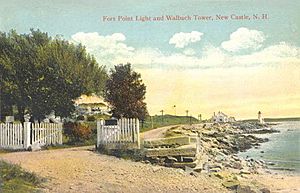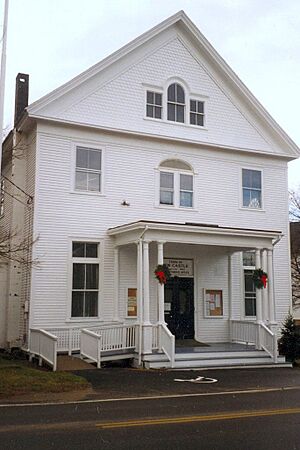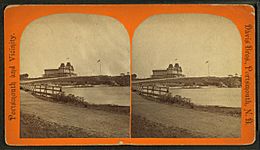New Castle, New Hampshire facts for kids
Quick facts for kids
New Castle, New Hampshire
|
|
|---|---|

Fort Point Light from Ocean Street
|
|

Location in Rockingham County and the state of New Hampshire.
|
|
| Country | United States |
| State | New Hampshire |
| County | Rockingham |
| Incorporated | May 30, 1693 |
| Area | |
| • Total | 2.27 sq mi (5.88 km2) |
| • Land | 0.81 sq mi (2.09 km2) |
| • Water | 1.46 sq mi (3.78 km2) 64.4% |
| Elevation | 30 ft (9 m) |
| Population
(2020)
|
|
| • Total | 1,000 |
| • Density | 1,237/sq mi (477.5/km2) |
| Time zone | UTC-5 (Eastern) |
| • Summer (DST) | UTC-4 (Eastern) |
| ZIP code |
03854
|
| Area code(s) | 603 |
| FIPS code | 33-50980 |
| GNIS feature ID | 0873676 |
New Castle is a small town in Rockingham County, New Hampshire, United States. It is special because it is the smallest and easternmost town in New Hampshire. It is also the only town in the state that is located entirely on islands.
In 2020, about 1,000 people lived in New Castle. The town is home to important historical sites like Fort Constitution Historic Site and Fort Stark Historic Site. It also has the New Castle Common, which is a 31-acre recreation area right on the Atlantic Ocean. You can also find a United States Coast Guard station and the famous Wentworth by the Sea hotel here.
Contents
History of New Castle
Early Settlement and Name
The main island where New Castle is located was first called "Great Island." People started settling here in 1623. An early defense structure, like a small fort, was built on Fort Point. This fort later became Fort William and Mary, which was rebuilt in 1808 as Fort Constitution.
In 1679, the area became a part of Portsmouth. On May 30, 1693, it officially became its own town and was named "New Castle" after the fort. Until 1719, the town of Rye was also part of New Castle.
Old Industries and Life
In the early days, the main jobs in New Castle were trading, running inns (taverns), and fishing. People also farmed, using seaweed as fertilizer for their crops.
The Stone-Throwing Devil
A very strange event happened in New Castle starting on June 11, 1682. It was called a "Stone-Throwing Devil." People reported that stones were thrown at George Walton's tavern by an "invisible hand." Windows were broken, and objects inside the house moved on their own.
This mysterious event continued for months. Hundreds of stones seemed to fall from nowhere onto Walton's tavern and the people nearby. No one ever saw who was throwing them. Other odd things happened too, like strange voices and items flying around.
George Walton was a Quaker, and at that time, Quakers were not well-liked by the Puritans. He was also a successful businessman, which made some of his neighbors jealous. This strange event became known throughout America and England. It was one of the first major reports of unusual happenings in America, and it came before the famous Salem witch trials in Salem, Massachusetts.
New Castle in the American Revolution
Fort William and Mary played a role in one of the first actions of the American Revolutionary War. On December 14, 1774, American colonists arrived in gundalows (small sailing barges). They raided the fort.
The fort's captain and five soldiers were greatly outnumbered and surrendered. The colonists took 100 barrels of gunpowder from the fort. They floated the powder up the Piscataqua River to inland towns like Durham. This gunpowder was later used in the 1775 Battle of Bunker Hill. The next day, the colonists returned and took 16 cannons and all the small weapons.
Connecting the Islands
In 1821, new ways to reach the island were created. Three bridges (now two bridges and a causeway) connected Frame Point in Portsmouth to Great Island. Before this, only one bridge on the southwestern side allowed access to New Castle without a boat.
The Wentworth by the Sea Hotel
New Castle was once a quiet fishing village. This helped keep its old colonial buildings safe. However, in 1874, the Hotel Wentworth was built on a hill with beautiful views of Little Harbor and the ocean.
A businessman named Frank Jones bought and improved the hotel. It became a very popular resort, growing so large it was like its own small village. In 1905, when President Theodore Roosevelt helped end the Russo-Japanese War with the Treaty of Portsmouth, diplomats from both countries stayed at the Wentworth by the Sea. They were taken by boat to the negotiations at the Portsmouth Naval Shipyard. The hotel was also featured in the 1999 movie, In Dreams.
Geography of New Castle
New Castle covers about 5.9 square kilometers (2.3 square miles). Most of this area, about 64.4%, is water. The town is an archipelago, which means it's made up of one main island (Great Island) and several smaller islands. These islands are surrounded by the Piscataqua River and the Atlantic Ocean.
The main part of the Piscataqua River flows around the north and east sides of Great Island. Little Harbor is to the south, and smaller islands are to the west within Portsmouth Harbor. The southeastern tip of the island, at Fort Stark, faces the Atlantic Ocean. The highest point in New Castle is at the Wentworth by the Sea hotel, which is about 30 feet (9 meters) above sea level.
Neighboring Towns and Cities
- Kittery, Maine (north)
- Rye (southwest)
- Portsmouth (west)
Population and People
| Historical population | |||
|---|---|---|---|
| Census | Pop. | %± | |
| 1790 | 534 | — | |
| 1800 | 524 | −1.9% | |
| 1810 | 592 | 13.0% | |
| 1820 | 932 | 57.4% | |
| 1830 | 850 | −8.8% | |
| 1840 | 742 | −12.7% | |
| 1850 | 891 | 20.1% | |
| 1860 | 692 | −22.3% | |
| 1870 | 667 | −3.6% | |
| 1880 | 610 | −8.5% | |
| 1890 | 488 | −20.0% | |
| 1900 | 581 | 19.1% | |
| 1910 | 624 | 7.4% | |
| 1920 | 728 | 16.7% | |
| 1930 | 378 | −48.1% | |
| 1940 | 542 | 43.4% | |
| 1950 | 583 | 7.6% | |
| 1960 | 823 | 41.2% | |
| 1970 | 975 | 18.5% | |
| 1980 | 936 | −4.0% | |
| 1990 | 840 | −10.3% | |
| 2000 | 1,010 | 20.2% | |
| 2010 | 968 | −4.2% | |
| 2020 | 1,000 | 3.3% | |
| U.S. Decennial Census | |||
In 2020, there were 1,000 people living in New Castle, in 436 households. Most of the people (94.9%) were White. About 2.7% of the population was Hispanic or Latino.
In 2010, about 22.1% of homes had children under 18. Most households (61.6%) were married couples living together. The average household had 2.26 people.
The median age in New Castle was 50 years old. This means half the people were younger than 50 and half were older. About 17.8% of the population was under 18.
New Castle is known as New Hampshire's wealthiest town based on how much money people earn per person.
Places to Visit
- Fort Constitution State Historic Site
- Fort Stark State Historic Site
- New Castle, NH Historical Society at the Old Library Museum
- Portsmouth Harbor Light (also called Fort Point Light)
Famous People from New Castle
- Harriet Ryan Albee (1829-1873), a social reformer who helped others.
- J.D. Barker (born 1971), a bestselling author.
- Samantha Brown (born 1970), a TV host who guides people on travel shows.
- George Frost (1720–1796), a sailor, judge, and representative to the Continental Congress.
- Benjamin Randall (1749–1808), a religious leader.
- Duncan Robinson (born 1994), an NBA basketball player for the Miami Heat.
- Edmund C. Tarbell (1862–1938), a famous American impressionist painter.
See also
 In Spanish: New Castle (Nuevo Hampshire) para niños
In Spanish: New Castle (Nuevo Hampshire) para niños









